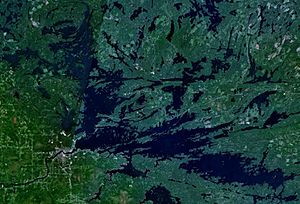Rainy Lake facts for kids
Quick facts for kids Rainy Lake |
|
|---|---|
 |
|
| Location | Minnesota, USA / Ontario, Canada |
| Coordinates | 48°38′13″N 93°01′53″W / 48.63694°N 93.03139°W |
| Type | remnant of former glacial Lake Agassiz |
| Primary inflows | Namakan Lake Kabetogama Lake Seine River |
| Primary outflows | Rainy River |
| Basin countries | Canada, United States |
| Max. length | 80 km (50 mi) |
| Max. width | 48 km (30 mi) |
| Surface area | 932 km2 (360 sq mi) |
| Max. depth | 50 m (160 ft) highly variable |
| Shore length1 | 1,500 km (930 mi) 2,520 km (1,570 mi) (w/ Islands) highly irregular, rocky shoreline |
| Surface elevation | 338 m (1,109 ft) |
| Islands | ~2,568 |
| Settlements | International Falls, MN Fort Frances, Ontario |
| 1 Shore length is not a well-defined measure. | |
Rainy Lake (which means Lac de la pluie in French) is a large lake located right on the border between the United States and Canada. It's a really important and beautiful lake that stretches about 80 kilometers (49 miles) long and 32 kilometers (20 miles) wide. The lake covers a huge area of about 894 square kilometers (345 square miles).
The Rainy River flows out from the western side of Rainy Lake. This river is used to create hydroelectric power, which is a clean way to make electricity for nearby towns like International Falls. Besides making power, Rainy Lake is a very popular place for boating and fishing.
Contents
Where is Rainy Lake?
Rainy Lake sits on the international border. This means one side of the lake is in Minnesota, USA, and the other side is in Ontario, Canada. It's a unique spot where two countries share a natural wonder.
How Big is Rainy Lake?
This lake is quite large! It has an area of about 932 square kilometers (360 square miles). Imagine a lake that's 80 kilometers (50 miles) long and 48 kilometers (30 miles) wide. That's a lot of water to explore!
Many Islands and Shoreline
Rainy Lake is famous for its many islands. There are around 2,568 islands scattered across the lake! The shoreline is very rocky and uneven, stretching for about 1,500 kilometers (930 miles). If you include all the islands, the shoreline is even longer, reaching about 2,520 kilometers (1,566 miles). This makes it a great place for exploring hidden coves and quiet spots.
How Rainy Lake Was Formed
Rainy Lake was formed a very long time ago by huge sheets of ice called glaciers. These glaciers moved across the land, carving out the landscape. When the glaciers melted, they left behind a large lake. Rainy Lake is actually a leftover part of a much bigger ancient lake called Lake Agassiz.
Water Flow and Rivers
Several rivers flow into Rainy Lake, bringing water from other areas. These include Namakan Lake, Kabetogama Lake, and the Seine River. The water then flows out of Rainy Lake through the Rainy River. This river then continues its journey, eventually reaching Hudson Bay.
Fun Activities on Rainy Lake
Rainy Lake is a fantastic place for outdoor adventures, especially for kids and families!
Boating and Exploring
With so many islands and a long, winding shoreline, Rainy Lake is perfect for boating. You can spend hours exploring different parts of the lake, finding quiet spots, or visiting some of the many islands. Many people enjoy kayaking, canoeing, and motorboating here.
Fishing Adventures
Fishing is one of the most popular activities on Rainy Lake. The lake is home to many different types of fish, including:
- Walleye
- Northern Pike
- Smallmouth Bass
- Crappie
- Muskellunge (often called "muskie")
It's a great place to try and catch a big one!
Nearby Parks and Nature
Part of Rainy Lake is located within Voyageurs National Park in Minnesota. This park is a beautiful area of forests, lakes, and wetlands. It's a wonderful place to see wildlife, go hiking, or learn about the area's natural history.
Cities on the Lake
Two main cities sit on the shores of Rainy Lake, right across from each other on the border:
- International Falls, Minnesota, USA
- Fort Frances, Ontario, Canada
These cities are important hubs for people visiting the lake and for local businesses.
History of Rainy Lake
Rainy Lake has a rich history. For thousands of years, Indigenous peoples lived around the lake, using its waters and lands for food, travel, and shelter. Later, European fur traders, like those from the Hudson's Bay Company, used the lake as a key route for transporting furs. The lake was an important part of their trade networks.
Images for kids
See also
 In Spanish: Lago Rainy para niños
In Spanish: Lago Rainy para niños



